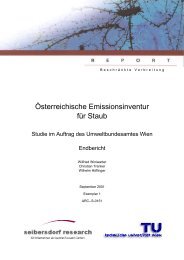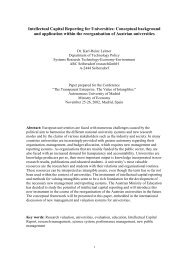ALPMON FINAL REPORT - ARC systems research
ALPMON FINAL REPORT - ARC systems research
ALPMON FINAL REPORT - ARC systems research
Create successful ePaper yourself
Turn your PDF publications into a flip-book with our unique Google optimized e-Paper software.
Contract ENV4-CT96-0359 <strong>ALPMON</strong><br />
wherein the NDVI was calculated analogue to classification result 3. The first part of this investigation<br />
will be published in the near future (Catalini, 2000).<br />
2.3.5.5 Conclusion<br />
The results produced by <strong>ALPMON</strong> cover most of the user requirements as stated in 2.3.5.2.2. From<br />
the eight required applications listed in Table 8, only one application was tested by the SNP for its<br />
feasibility. All the classification results delivered to the SNP (Table 9) have been integrated into two<br />
ongoing mountain ungulate projects. The monitoring of grazing areas of red deer is one of the<br />
applications for which classified remotely sensed data serves as input to better understand the habitat<br />
analysis of red deer. Information on the distribution of grassland at different times of the year and open<br />
forest shows potentially used grazing areas. Classification results were also used to build a virtual<br />
world for the red deer, in order to model their behaviour. Results of the feasibility of these satellite<br />
classifications have not been established yet, as the work is still ongoing.<br />
The remaining applications have not been tested by the customer for the following reasons:<br />
� Many applications require that the inventoried vegetation parameters have a minimum area of<br />
20x20m. This could not achieved, since the highest spatial resolution was 30m (Landsat TM) for<br />
multi-spectral satellite data, which has the necessary near-infrared and SWIR (short wave infrared)<br />
bands for the required vegetation investigations. Unfortunately, no SPOT data (20m) was<br />
available. For the monitoring of geomorphologic processes (erosion, rock slides), 6mpanchromatic<br />
satellite data was tested.<br />
� The spatially comprehensive inventory of trees species composition and forest stand density could<br />
not be provided with a sufficient accuracy. As a consequence of the mediocre results, the<br />
classification of forest age class was omitted. Probably for this reason, applicability of the<br />
classification results for a number of listed applications was not followed through, since all of these<br />
categories were needed.<br />
� The <strong>research</strong> carried out on mountain ungulates is the core <strong>research</strong> topic of the Swiss National<br />
Park, thus the monitoring of grazing areas of red deer was the most important application. All other<br />
applications have lesser priority, since they are of interest by other <strong>research</strong>ers not working for the<br />
Swiss National Park, but using the park as their <strong>research</strong> field.<br />
In conclusion it has to be summarised that the Swiss National Park Administration has been positively<br />
convinced of the use and employment of this modern technology of remote sensing data. Visual<br />
verification of provided classification results has been carried out by our customer. Also, several results<br />
have been delivered as input to different mountain ungulate <strong>research</strong> projects and diploma theses,<br />
which are still in the process of being analysed. Unfortunately, no feedback on the results of the<br />
integration of satellite image classifications is available, since the classified satellite data is still being<br />
used in ongoing <strong>research</strong> and management work.<br />
2.3.6 Integration into CORINE-Landcover<br />
2.3.6.1 Introduction and Objectives<br />
Objective of this work package is the investigation on how far the results of <strong>ALPMON</strong> can be integrated<br />
into EU activities such as the CORINE land cover project. In contrary to the CORINE land cover<br />
project, which is based on visual interpretation of analogue satellite imagery, the <strong>ALPMON</strong> approach<br />
relies to a high extent on automated processing of digital data.<br />
The aim of the CORINE („Co-ordination of Information on the Environment“) land cover project was to<br />
map the land use / land cover of Europe within the framework of the CORINE Program of the<br />
European Union. The European Environment Agency (EEA) in Copenhagen was in charge of the<br />
CORINE Program; co-ordination and support was performed by the „European Topic Centers on Land<br />
Cover“ (ETC/LC). The Project was carried out by so called „National Reference Centres“ (NRC) in the<br />
member states.<br />
The „Co-ordination of Information on the Environment“ for Europe offers the possibility of comparing<br />
environmental data between the Member States. Furthermore the data can be a useful tool for<br />
environmental applications and <strong>research</strong> at European level. For this reason it is necessary to have a<br />
unique methodology for collecting the same basic data on land cover / land use for all collaborating<br />
JR, RSDE, ALU, LMU, Seibersdorf, WSL 57




